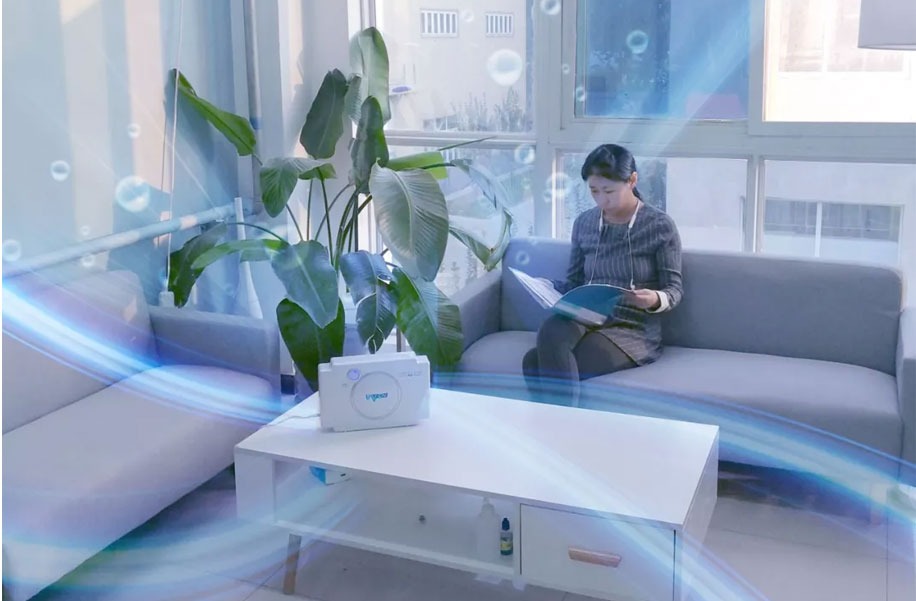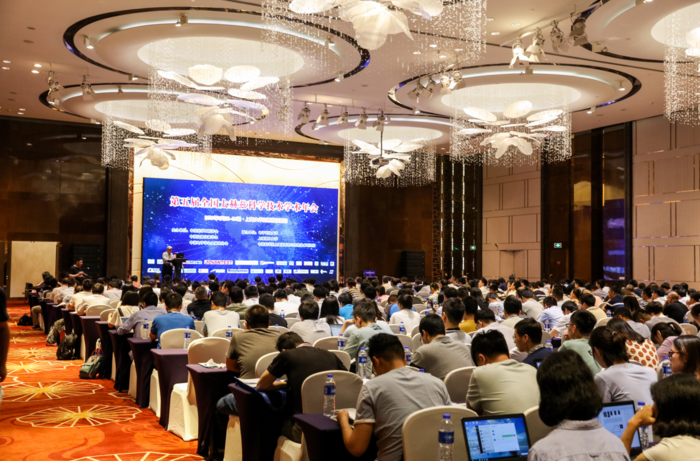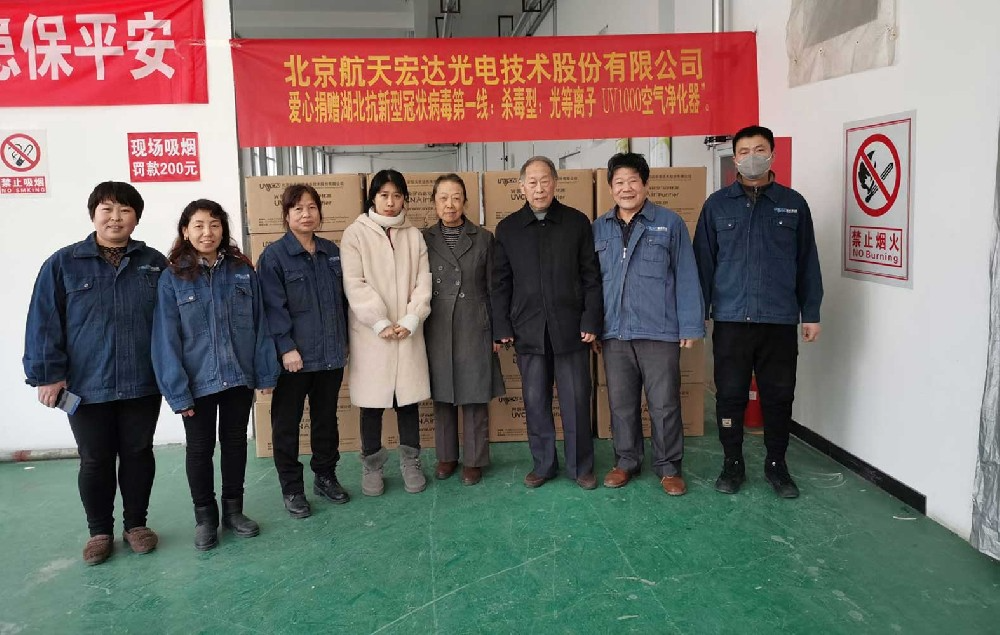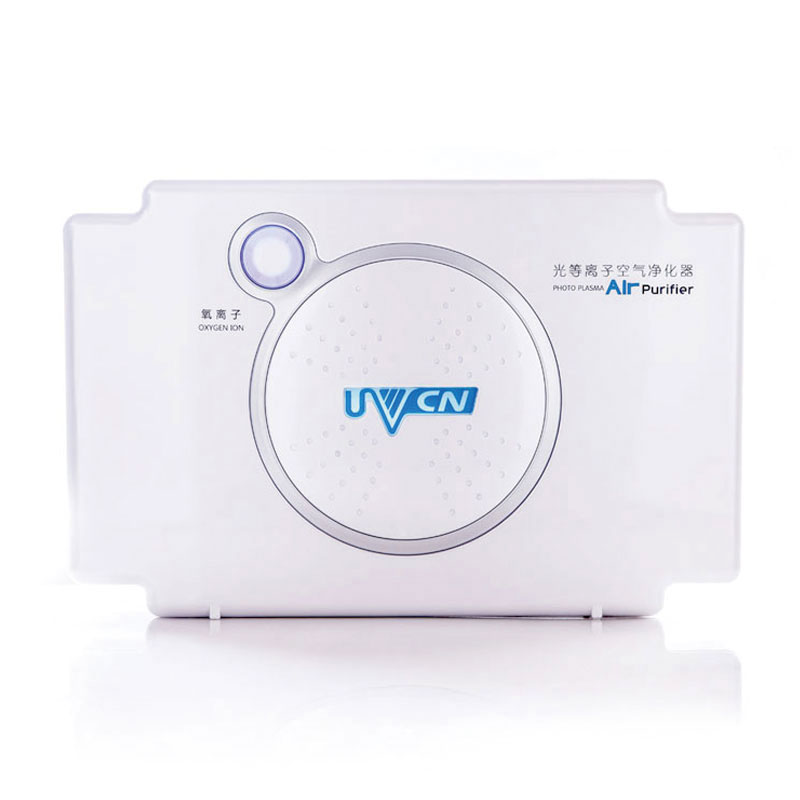In recent years, air purifiers have gradually become popular, starting from the haze that began in 2014, which has sparked unprecedented attention to air governance and purification in the Chinese market. Purifiers have become hot selling products at this time. Since the emergence of smog, media promotion has focused on particulate matter. Major brands and businesses have launched purifiers with filters to remove PM2.5, including Philips, Xiaomi, and Honeywell, which have become hot selling products. Businesses have seized this opportunity and started selling various purifiers aggressively. You will find that there are still many unknown purifier manufacturers, who used to make clothing, sell jeans, and injection mold factories are all making purifiers. The various brands of purifiers we can see on the market now claim to be able to remove 99.9% of formaldehyde and haze. Consumers only ask if the purifier can filter out particulate matter and remove haze. This is like designing a very good filter for cigarettes, layer by layer filtering, but no one believes that the filter can filter out the carcinogens of cigarettes. Smoking is still extremely harmful to the body, and even can lead to lung cancer. The hospital's clean rooms are very clean, and medical staff wear isolation protective clothing, but they cannot isolate SARS, Ebola virus, and the recent coronavirus.
Filtering particulate matter is just an interception behavior, which is equivalent to cleaning the room and sweeping away dust. However, bacteria, viruses, and harmful substances are beyond your control, which is why you feel that current purifier products are useless.
Filtering technology is just a form of interception, which belongs to physical methods. It does not actively change the molecular structure of the air. Only in terms of dealing with haze, blocking particulate matter is only the most basic part. If you do not process and decompose the particulate matter accumulated in the filter after intercepting particulate matter, the reproduction of bacteria and viruses will be very rapid. Every time you turn on the purifier, it's a second pollution.
The most critical issue regarding the bacteria and viruses carried by smog was not given much attention at that time.
Air purification ≠ filtering particulate matter
Nowadays, most families have bought purifiers, and some even buy several purifiers at home. Consumers' understanding of purifiers is that of filters, and their understanding of air is that of the amount of particulate matter. They believe that purifiers are only needed when there is haze, and air purification relies on filtering through a filter. This is the majority of people's understanding of "air purification". And many people forget that there are several major factors that affect the quality of air:
1. Bacteria, viruses, toxic and harmful gases (including TVOC, formaldehyde, benzene from decoration pollution)
2. Odor
3. Particulate matter
The core words for air purification should be: toxic and harmful gases, bacteria, viruses
And when we face an air problem, how to solve it? When it comes to purifiers, the answer we get is uncertain:
For example, regarding the question of "air purifiers that can remove formaldehyde", I searched on Baidu and found that most of the answers said that purifiers cannot remove formaldehyde, which is misleading. Some answers are quite fairy tale, asking plants to remove formaldehyde... How much pressure do plants face? They are just a plant without even a soul. Can they just be a peaceful plant?
There are basically several types of products on the market now:
1. The HRPA filter screen adsorbs and filters particulate matter onto the filter screen. This principle does not depend on the big brand or the cost, it is just one principle: fan+filter screen, multiple layers. The so-called new technology filter, high-tech filter, but it's just a filter, still a filter! There are many problems with this type of purifier. If it is targeted at particulate matter, then even if it is made with a large volume of over one meter high, it needs to be circulated by a fan to process the entire room. In fact, the processing capacity is not enough. The noise is loud and the power consumption is not small.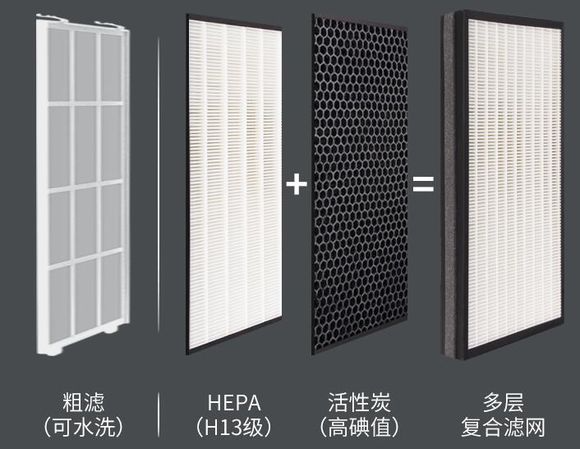
We know that particulate matter in smog is harmful, and the filter uses limited power to adsorb some of it online. But is that all? Put all the dust particles and various haze viruses that everyone is panicking about on the filter. It hasn't disappeared or undergone any chemical changes, and the haze is still the same. Then, in a very comfortable and warm room with appropriate humidity, what will happen to the large amount of dust particles on the filter. Imagine the speed at which bacteria reproduce, so many people say that there is a smell when the filter machine is turned on, and that's the problem.
Whether it is a manufacturer or a company that produces purifiers, they have not found a true purification method, so they have come up with this method, "filtration"
I don't know that you still remember SARS, and the novel coronavirus in 2020, which makes us all have a weak fear. No matter how good the protection is, doctors in the hospital's clean ward wear protective clothing and gas masks, they can't avoid infection?
Generally, the detection of haze by air purifiers is mainly based on the amount of particulate matter. However, it has not been considered that the amount of particulate matter has decreased and is not in the air. Instead, harmful substances such as bacteria, viruses, and microorganisms contained in the particulate matter on the filter screen are not detected. No one wants to test this value. What everyone cares about is the amount of particulate matter.
So the issues we are concerned about, such as formaldehyde, TVOC, harmful gases, and odors, are not within the scope of filters.
Many filter purifiers exaggerate their ability to remove formaldehyde... Can you filter out a virus for me
Simply put, if the filter element is not replaced regularly, it will blow the filtered pollutants back into the room again. The timing of filter replacement is difficult to control
Some users who have purchased Honeywell purifiers have reported that after the new machine is turned on, the smell in the room disappears for a while. After turning it off and back on, the smell blows out again.
So, for filtration technology, it can only be called clean technology, not purification. The word 'purification' should come from a verb and should be an active purification, not a passive purification.
The second method: activated carbon
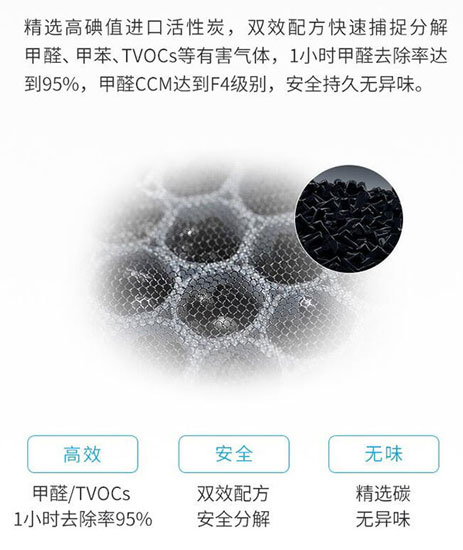
Activated carbon is also used for gas masks, and many car purifiers also use this. Generally, activated carbon is added to the filter purifier to remove formaldehyde. Activated carbon has many small pores, which can adsorb harmful gases such as formaldehyde when they fly in. However, the problem is that once the adsorption is full, the small pores are occupied and cannot be adsorbed anymore. If not replaced in time, activated carbon becomes a carrier of toxic substances under appropriate temperature and humidity conditions. (Similar to the issue of timely replacement of filters)
This is also a passive purification method, which is to wait for formaldehyde to come into my bowl... If it can't fit anymore, let it be. I can't control it anymore. That's it
The third type: photocatalyst, also known as photohydrogen ion
There are many purifiers, and they also advertise that they have added UV sterilization.
Baidu photocatalyst: Photocatalyst is a general term for photocatalytic semiconductor materials represented by nanoscale titanium dioxide. It is coated on the surface of the substrate and produces strong catalytic degradation function under the action of ultraviolet light. It can effectively degrade toxic and harmful gases in the air; It can effectively kill various bacteria and decompose and harmless the toxins released by bacteria or fungi; It also has functions such as deodorization, anti pollution, and air purification.
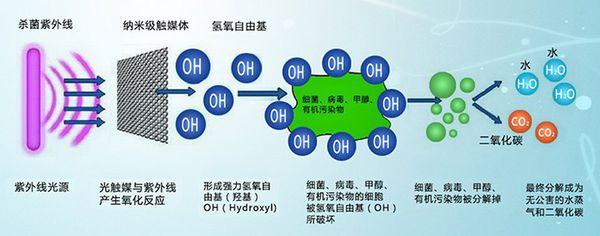
Photocatalyst has the effect of removing formaldehyde, but it also belongs to passive treatment. Photocatalyst needs to be sprayed on the coating and wait for formaldehyde to fall on the coating and react, but... As long as a speck of dust or something else falls, formaldehyde molecules cannot come into contact with the photocatalyst coating.
Simply put, photocatalytic purification is a two-dimensional purification process that only deals with a single plane, not the entire space.
In addition, the ultraviolet here plays a role in exciting the photocatalytic reaction, but little do you know that this is like picking sesame seeds after losing a watermelon. The high-energy ultraviolet light source itself produces ground state oxygen atoms, which have a much stronger ability to decompose formaldehyde than photocatalysts.
So why do people say that buying a new machine has some effect? Because of passive processing, once the adsorption is full and dust falls on it, it is useless. The effect is very weak.
(Another important point to note is that photocatalysts come with ultraviolet radiation, and manufacturers may claim that they contain purification functions such as ultraviolet sterilization and disinfection. This is important to be cautious as the ultraviolet radiation used here is only designed to stimulate the photocatalyst and limits its structural space, making it ineffective in sterilization.)
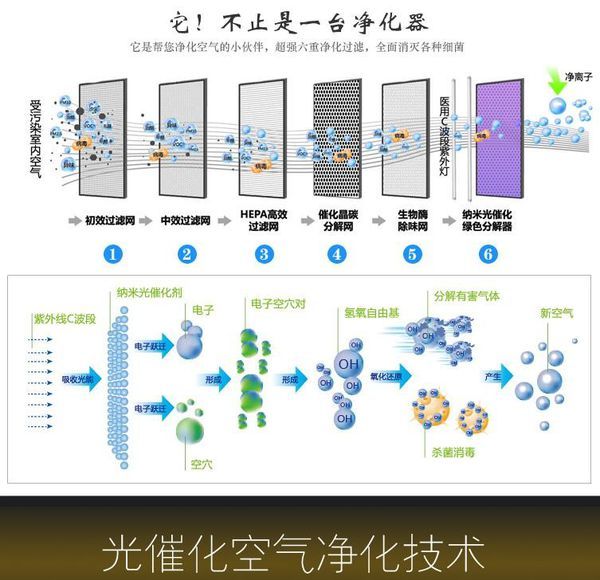
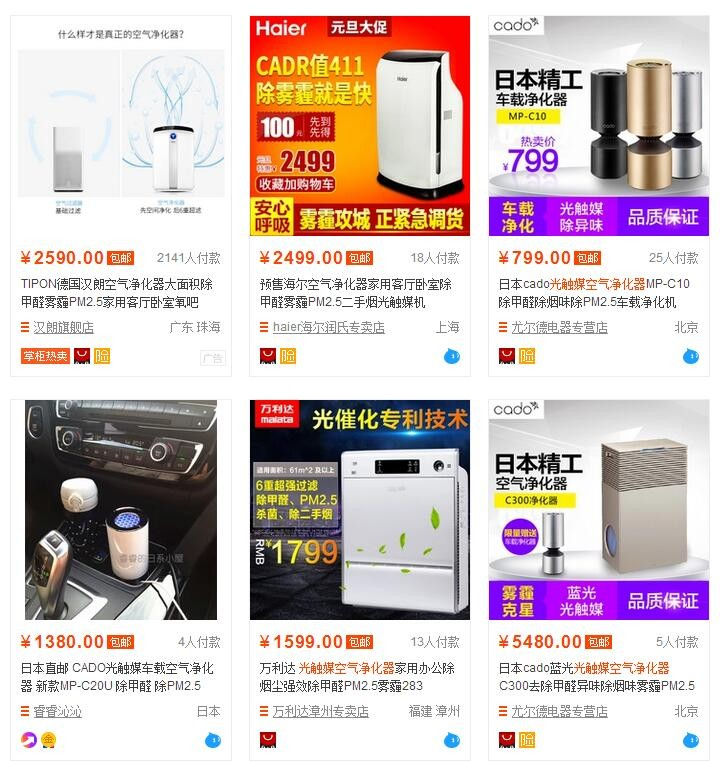
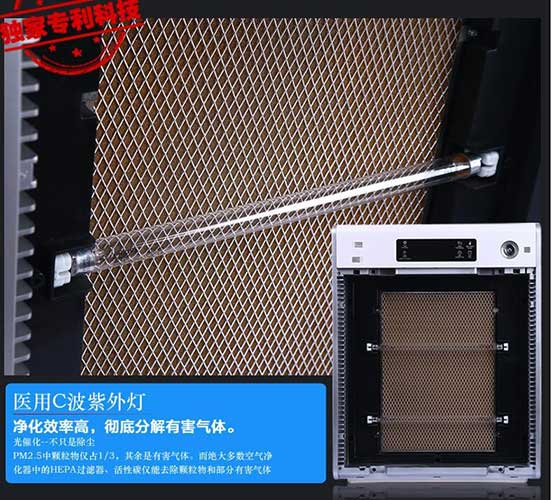
The photocatalytic technology uses a 254 nanometer wavelength medical ultraviolet lamp to excite the hydrogen oxygen machine of the photocatalyst to produce formaldehyde, which is a two-dimensional purification concept. The ultraviolet lamp used is also a medical ultraviolet of ordinary production process, and its design is limited to the barrier of the photocatalyst filter layer. Therefore, the function of the ultraviolet lamp is not much sterilization except for exciting the photocatalyst. Nowadays, most photocatalytic purifiers also combine activated carbon and filtration technology, but they are not the most fundamental solution
Fourth type: electrostatic precipitator
Electrostatic air purifiers use a high-voltage electrostatic field to adsorb fine dust while also ionizing nitrogen in the air to produce nitrogen oxides and pollutants.
This type of device can be quite dangerous to use, especially in humid environments in the south. There are many limitations, such as not being able to use it in cars.
The traditional ozone generator operates on the same principle, utilizing high-voltage discharge to generate ozone for sterilization. It should be noted that this type of ozone ionizes nitrogen in the air and produces nitrogen oxides, which are carcinogenic substances. (As I will talk about later, plasma purifiers also have ozone, but we call it "reactive oxygen species", which smells like ozone. However, the difference between the latter is that pure ozone produced by using ultraviolet short wave light has completely different components and effects. Ozone produced by light has no carcinogens, low power consumption, and a very gentle production method.) High voltage discharge air purifiers also have this secondary pollution problem. But now market promotion only greatly amplifies its impact and avoids secondary pollution.
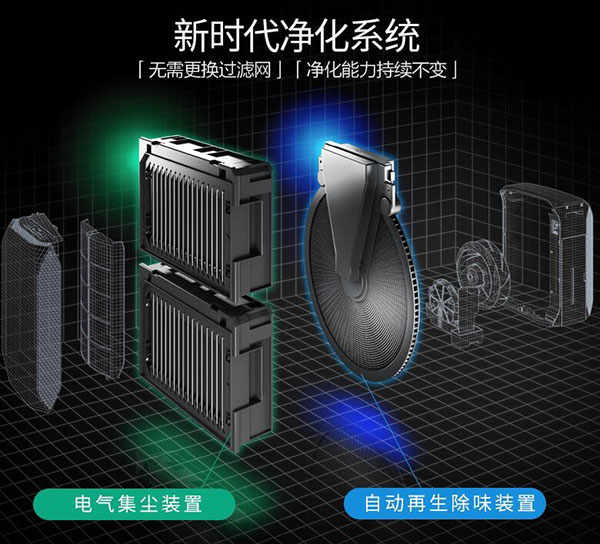
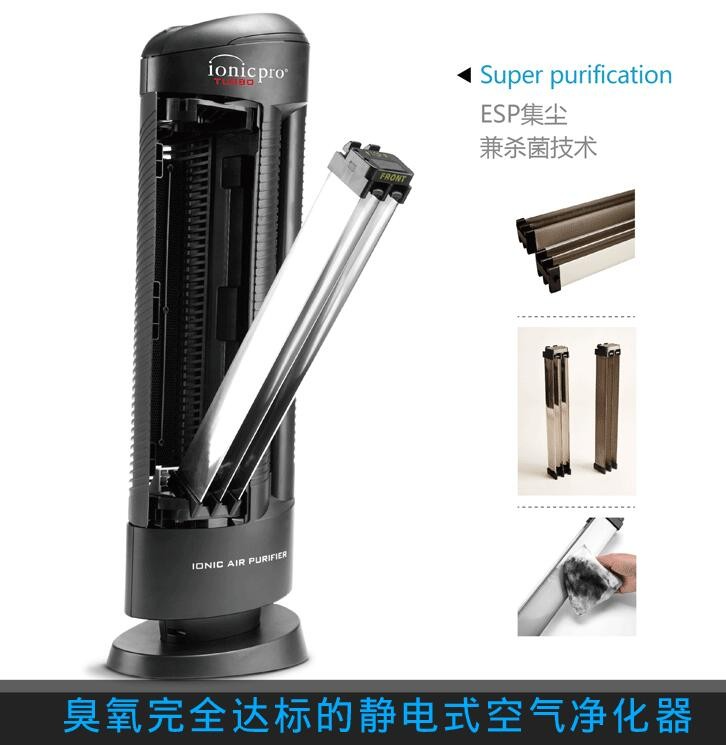
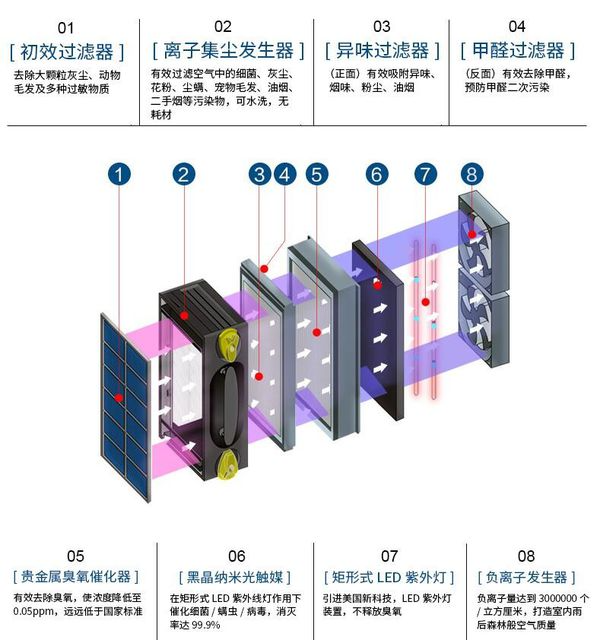
Non consumable purifiers can also be combined with photocatalysts, filter activated carbon, negative ions, and dust collectors. All kinds of filtering and adsorption principles are added together, but the effect is short-lived and not the fundamental solution. Generally, when searching for "non consumable purifiers" on Taobao, this type of electrostatic dust collector purifier is usually found, or negative ion purifiers are sold for six or seven thousand yuan on Taobao, and it is said that no consumables are needed.
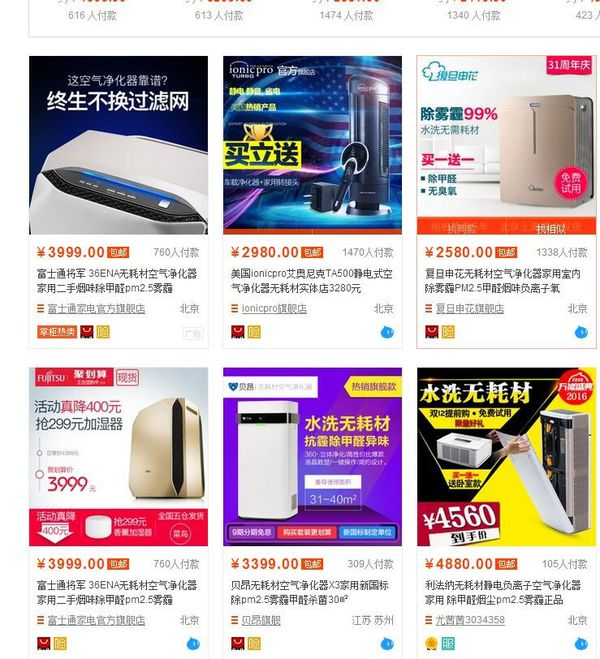
Actually, electrostatic precipitators are suitable for industry and not for civilian use.
Baidu search: A method of gas dust removal. When dusty gases pass through a high-voltage electrostatic field, they are electrically separated, and the dust particles combine with negative ions to carry a negative charge and tend to discharge and deposit on the anode surface. Used in industries such as metallurgy and chemistry to purify gases or recover useful dust particles. A dust collection method that uses an electrostatic field to ionize gas and charge dust particles to adsorb onto electrodes. In a strong electric field, air molecules are ionized into positive ions and electrons. During the process of electrons rushing towards the positive electrode, they encounter dust particles, which are negatively charged and adsorbed onto the positive electrode for collection. Of course, in recent years, through technological innovation, there have also been methods of using negative electrode plates to collect dust. Usually used in factories and power plants that use coal as fuel to collect coal ash and dust from flue gas. In metallurgy, oxides such as tin, zinc, lead, and aluminum are collected, and now there are also dust removal and sterilization products that can be used in homes. The plasma technology mentioned now, low-temperature plasma technology, and electrostatic precipitator are both the same thing, they are both high-voltage discharge
The fifth type: Regarding ozone:
The ozone mentioned by our current purifier or ozone equipment: (In 1840, German C.F. Shebairn discovered that a special odor gas was released when he electrolyzed dilute sulfuric acid, so he named it ozone. In 1785, when Germans were using electric motors, they found that an odor was produced when the electric motors were discharged. In 1840, French scientist Christian Frieder identified it as ozone.) When humans discovered ozone, the ozone was named as the ozone produced by high-voltage discharge. This type of ozone ionizes nitrogen in the air, producing carcinogenic nitrogen oxides, so we say that the ozone produced by traditional ozone generator devices is harmful. This type of ozone does not contain ground state oxygen atoms or hydrogen oxygen machines, and only has a sterilizing and disinfection effect, with little effect on formaldehyde.
Another type of ozone, which we refer to as ozone in nature, is produced through ultraviolet radiation. Humans are able to survive due to the protection of the ozone layer. At the forest seaside with good air quality, the ozone content is relatively high and the air is fresh.
And plasma purification technology imitates the purification principle of nature, using ultraviolet to generate ozone. Very pure, this type of ozone is called "reactive oxygen species", so please note that "ozone" and "reactive oxygen species" are two different concepts. The former is generated by high-voltage discharge, while the latter imitates the natural environment and produces ozone through ultraviolet radiation.
Sixth type: Negative ion technology
The concentration of negative ions in the air is one of the indicators of good or bad air quality, and the World Health Organization has also established relevant regulations on the standard concentration of negative ions in fresh air. China has also incorporated negative ions into its meteorological monitoring system, which has wide applications in areas such as air environment protection.
We usually feel extremely fresh air near waterfalls, in forests, and after thunderstorms, because the air contains a large number of negative ions. Crystal gypsum lamps can emit natural negative ions, which is particularly effective in balancing the content of positive and negative ions in the air when heated and in enclosed rooms.
Negative ions are known as "air vitamins", and their functions include: removing dust, floating hair, odors, smoke, sterilization, purifying the air, treating pollen, dust, pet hair, spore allergies, improving respiratory diseases such as asthma, improving mood swings, depression, chronic fatigue, relieving mental stress, and so on. In short, they are of great benefit to people's health, emotions, and energy.
By using artificial negative ion generation technology, ecological grade small particle size air negative ions are generated, simulating the high-voltage ionization of air by lightning in nature to produce negative electrons, which are transmitted through oxygen, carbon dioxide, and other carriers in the air.
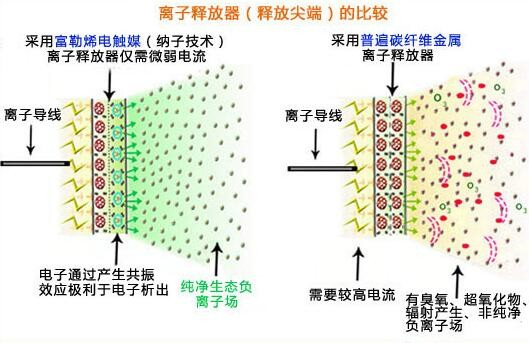
Our plasma purifier also includes the addition of negative ions. He can serve as an auxiliary for refreshing and dust removal, but many purifiers rely solely on negative ion purification effect and ability, which is not enough.
The seventh method: UV technology UV sterilization and disinfection is the use of appropriate wavelengths of ultraviolet light to destroy the molecular structure of DNA (deoxyribonucleic acid) or RNA (ribonucleic acid) in microbial cells, causing growth cell death and/or regenerative cell death, achieving the effect of sterilization and disinfection. UV disinfection technology is based on modern epidemic prevention, medicine, and optodynamics. It uses specially designed high-efficiency, high-intensity, and long-life UVC band ultraviolet light to irradiate flowing water, directly killing various bacteria, viruses, parasites, algae, and other pathogens in the water.
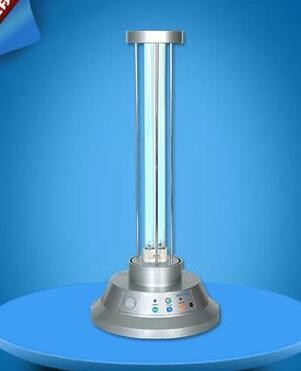
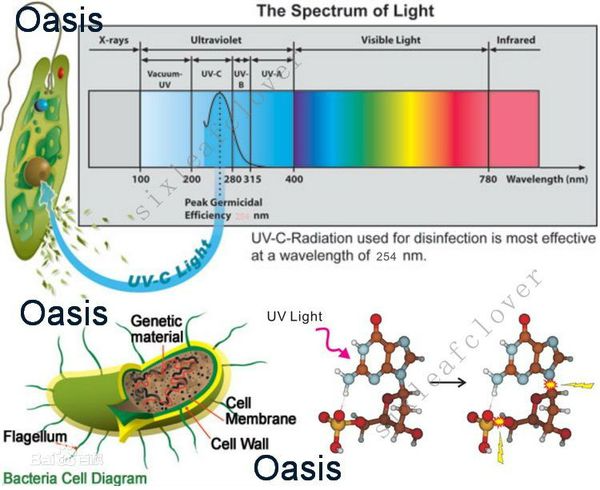
There are also some air disinfection machines or ultraviolet lamp sterilization devices on the market now. The ultraviolet lamp sterilization and disinfection commonly used in hospitals is commonly known to everyone. This is very different from 'optical plasma technology'. Most ultraviolet lamps used in hospitals operate in the 254 frequency band. Using boronated glass material, the cost is relatively low and the ultraviolet transmittance is very low. The service life is generally several hundred hours, and the UV attenuation is also fast.
Many purifiers have added ultraviolet lamps to increase their selling points.
However, the difficulty of applying ultraviolet technology is high, and there are few mature technological applications both domestically and internationally.
Many purifiers are equipped with ultraviolet light, which is a very cheap ultraviolet lamp, and the design structure cannot fully utilize the ultraviolet effect.
The traditional ultraviolet technology usually uses direct irradiation for sterilization, while the "photoplasma technology" that will be discussed next is also ultraviolet technology, but the difference is significant.
Eighth purification technology: Photoplasma technology:
The reason why it is called plasma technology instead of ultraviolet purifier is because it uses the principle of light to purify, rather than directly irradiating to kill viruses and purify. It is the principle of actively decomposing harmful gases by dispersing plasma generated by different wavelength combinations of ultraviolet light into the air. So the technical difficulty is relatively high, and this is a complex optical design. UV technology is applied in air purification products, and only a few companies in the world possess this technology. Due to its technical difficulty, complex design structure, and extremely high requirements for internal components, its cost is tens of times higher than that of ordinary purifiers.
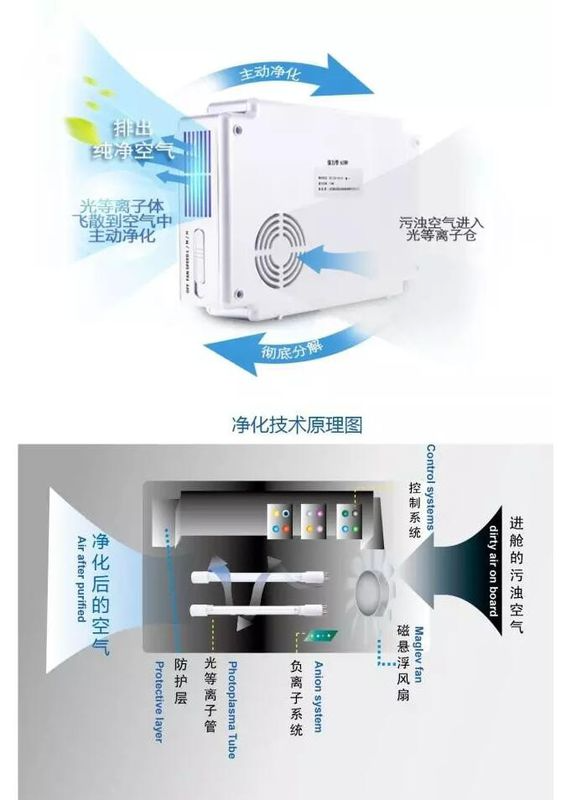
The energy level of the ultraviolet core component of the plasma is very high, which is different from ordinary ultraviolet lamps. Therefore, the purifier is equipped with a metal stainless steel protective cover inside, and the casing is also coated with electroplating technology. Don't worry about UV leakage and radiation issues. What is seen from the air vent is only the reflected light of the metal protective cover. UV technology is both an ancient and a new technology, and it is also a double-edged sword. To make good use of it, one needs to be able to master its cutting-edge technology. It's not easy to solve many technical problems either.
Scientific Explanation of Photoplasma
Purifying Photoplasma Technology
It is an advanced oxidative degradation technology formed by advanced photochemical reaction technology. Photoplasma has the following energy compositions:
Dual wavelength (UVC, UVD) ultraviolet light+(photoactivation) → pure ozone (O3)+atomic oxygen (O)+ground state oxygen (O *), through a special ultraviolet light source with two wavelengths, can generate a series of strong sterilization and disinfection light and electric plasma clusters, collectively known as photoplasma.
The main elements of all organic pollutants (bacteria, viruses, formaldehyde, ammonia, benzene, TVOC, etc.) are H and C (carbon and hydrogen), with relatively stable molecular structures. The basic principle of purification and degradation using photoplasma is that organic compounds (hydrocarbons) undergo photosensitive processes under specific wavelengths (UV-C) and specific intensities of ultraviolet radiation. That is, after the molecules of organic compounds absorb photon energy at specific wavelengths, the molecular chains are torn and decomposed into ions, free atoms, excited molecules, or neutral molecules; Meanwhile, under the irradiation of specific wavelengths (UV D) and intensities of ultraviolet radiation, oxygen molecules (O2) in the air absorb photon energy and transform into ozone (O3), atomic oxygen (O), and ground state oxygen (O *); These elements have very active chemical properties and strong oxidizing effects. They are strong oxidants that can completely oxidize the photosensitive decomposition products of organic matter, turning them into volatile harmless gases such as water vapor (H2O) and carbon dioxide (CO2), achieving the goal of thoroughly removing pollutants. Compared with other traditional purification methods, this purification result is clean, thorough, residue free, and does not cause secondary pollution.
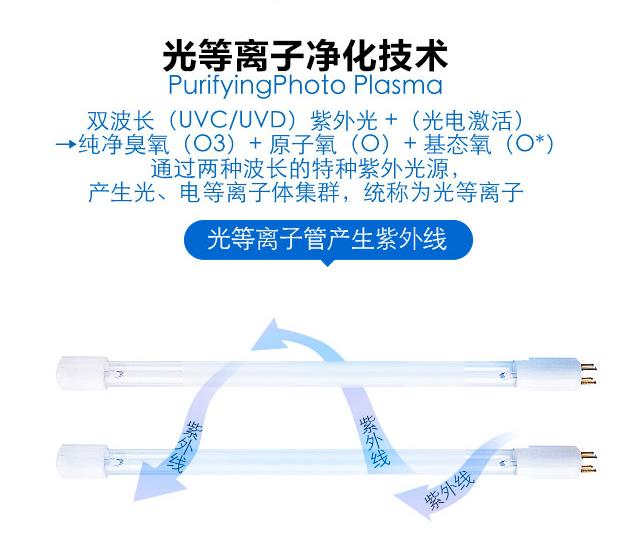
In summary, in order to solve the problem of air pollution, a true air purifier not only needs to intercept and filter particulate matter, but also needs to consider the ability to handle bacteria, microorganisms, toxic and harmful gases in order to truly purify the air. How to choose the right product is already a matter of everyone's health.
Of course, to truly solve the air problem, the best solution should ultimately be a more comprehensive air purification system that perfectly combines various purification technologies to achieve the most ideal use effect.


